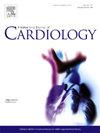Cumulative plaque burden analysis for phenotyping epicardial coronary artery disease
IF 3.2
2区 医学
Q2 CARDIAC & CARDIOVASCULAR SYSTEMS
引用次数: 0
Abstract
Background
Intravascular ultrasound (IVUS) reveals the location and burden of coronary artery disease (CAD) but is traditionally limited to segment-level analysis. We introduced the cumulative plaque burden index (CPBi), derived from AI-powered quantitative IVUS analysis, to characterize CAD morphological patterns across the entire vessel.
Methods
In this ASET JAPAN sub-study, pre- and post-percutaneous coronary intervention (PCI) IVUS and angiography were analyzed. Plaque burden was quantified per millimeter on the pre-PCI IVUS. After filtering out plaque burden <40 %, CPB curves were generated to visualize morphological patterns. CPBi, a continuous metric derived from the CPB curves, was calculated to represent morphological patterns, with lower values indicating diffuse disease. Physiological CAD patterns were characterized by Murray law-based quantitative flow ratio (μFR)-derived pullback pressure gradient (PPG). Percentage reclassification was analyzed by comparing CPBi-derived CAD patterns with those derived from visual assessment and μFR-derived PPG.
Results
CPB analysis was feasible in 130 out of 138 vessels, quantifying 8101 mm of plaque burden. The Median CPB index (CPBi) was 0.45[0.32–0.58], significantly correlating with μFR-derived PPG (r = 0.35, p < 0.001). Diffuse morphological pattern (low CPBi tertile) was associated with higher percent atheroma volume, longer segments with ≥40 % plaque burden, and longer stents. CPBi reclassified 55.4 % of visually assessed and 46.2 % of μFR-derived CAD patterns.
Conclusions
AI enables quantitative plaque burden analysis of the entire IVUS pullback, allowing visualization of morphological patterns via CPB curves and quantification with CPBi, which is associated with atherosclerosis severity and hemodynamics. Future studies need to validate the clinical implications of CPB analysis.

求助全文
约1分钟内获得全文
求助全文
来源期刊

International journal of cardiology
医学-心血管系统
CiteScore
6.80
自引率
5.70%
发文量
758
审稿时长
44 days
期刊介绍:
The International Journal of Cardiology is devoted to cardiology in the broadest sense. Both basic research and clinical papers can be submitted. The journal serves the interest of both practicing clinicians and researchers.
In addition to original papers, we are launching a range of new manuscript types, including Consensus and Position Papers, Systematic Reviews, Meta-analyses, and Short communications. Case reports are no longer acceptable. Controversial techniques, issues on health policy and social medicine are discussed and serve as useful tools for encouraging debate.
 求助内容:
求助内容: 应助结果提醒方式:
应助结果提醒方式:


